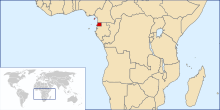Equatorial Guinean Spanish
The Equatorial Guinean Spanish is the modality of the Spanish language , which in the African state of Equatorial Guinea is spoken. This modality is characterized by African elements in phonology , morphology and vocabulary .
Brief historical overview
For the main article, see History of Equatorial Guinea
In 1778 the island of Fernando Poo (today: Bioko ) off the African continent became Spanish, in 1843 the Spaniards reached the mainland zone of Río Muni (today: Mbini ). In 1884 the Spaniards acquired the island of Annobón , and in 1900 also Río Muni. The colonization of these Spanish-Guinean areas did not take place until the end of the 19th century; In 1968 Equatorial Guinea became independent.
During the colonial days, the mission schools attached particular importance to the teaching of the Spanish language, and those who received such training were usually able to speak and write the language. When the territory was allowed to rule itself, political decisions made for an upswing in indigenous languages and the knowledge of "correct" Spanish declined. Spanish has been the official language in Equatorial Guinea since 1979 and the language of choice in education, work and culture since 1982, but many Equatorial Guineans have had serious spelling problems since the 1970s. Today, Spanish is the second language of much of the population of Equatorial Guinea.
Today Equatorial Guinea is the only state and, with the exception of the cities belonging to Spain on the African Mediterranean coast ( Ceuta and Melilla ), the only region in Africa in which Spanish (alongside Portuguese and French ) is the official language. In contrast to most of the countries of Hispanic America , Spanish is not spoken by the majority of the population in Equatorial Guinea. Spanish is the official national language and, like French since 1997, is used for intercultural communication, while the majority of the local population speak the Bantu languages Fang and Bube . Nevertheless, Nigerian, Cameroonian, Gabonese and South African students in particular come to Equatorial Guinea today to improve their language skills.
Phonological peculiarities
In Equatorial Guinean Spanish, in contrast to “Standard Spanish”, there is no phonetic distinction between the R-sounds / r / and / ɾ /, which means that minimal pairs such as carro ('car') and caro ('expensive') become homophonic . / b /, / d / and / g / are always pronounced occlusively and not as approximants , the phonemes / p /, / k / and / t / can be sonorized .
As in large parts of Hispanic America, the phenomena Yeísmo and Seseo exist, i.e. a non-distinction between / ll / (standard Spanish: [ ʎ ]) and / y / ([ j ]) or from / z / (standard Spanish : [ θ ] ) and / s / ( [ s ] ). The [ ʎ ] is only weakly expressed or entirely omitted. The / j / varies between velar and aspirated pronunciation, the / f / is bilabial [ .phi ] or [ thetav ] pronounced.
Among the Bubi , the / r / is pronounced guttural as [ ʀ ] as in French . The Ndowe , who speak Ngumbi as their mother tongue , often confuse [ g ] and [ x ] (for example gujar instead of jugar ).
Morphosyntactic peculiarities
In Equatorial Guinea, the feminine is used more often than in the rest of the Spanish-speaking world and the article is often left out. The use of the tú (“you”) and Usted (“you”, Ez. ) As well as the indicativo and subjuntivo are not subject to the same rules as in Spain. However, as in Spain, the vosotros ("you") and not in its place as in Latin America the politeness form Ustedes ("you", Mz. ) Is generally used.
Spanish-language literature from Equatorial Guinea
The best- known Spanish-speaking writers from Equatorial Guinea are Juan Tomás Ávila Laurel , Antimo Esono , María Nsué Angüe , Juan Balboa Boneke , Donato Ndongo-Bidyogo , Raquel Ilonbé , Constantino Ocha'a Mve Bengobesama and Leoncio Evita Enoy .
The origin of literary creation in Equatorial Guinea lies in the mission magazine La Guinea Española , first published in 1903 ; the first novel from this country is Cuando los combes luchaban (Novela de costumbres de la Guinea Española) ("When the Combé fought (novel about the customs of Equatorial Guinea) ", 1953, Leoncio Evita Enoy). In 1962 Daniel Jones followed Mathamas Una lanza por el Boabí . Since the 1980s there has been a resurgence of Spanish-language literature from Equatorial Guinea. However, in most anthologies on Spanish-language literature and Africa's literature in European languages, there are no references to Spanish-language Equatorial Guinean works.
Web links
- El español de Guinea Ecuatorial en el contexto del español mundial (Spanish; PDF file; 214 kB)
- The Spanish of Equatorial Guinea: research on la hispanidad's best-kept secret (English; PDF file; 122 kB)
- Breve apunte sobre el español en Guinea Ecuatorial ( Memento of September 22, 2008 in the Internet Archive ) (span.)
- El caso del español en Guinea Ecuatorial (span .; PDF file; 1.2 MB)


